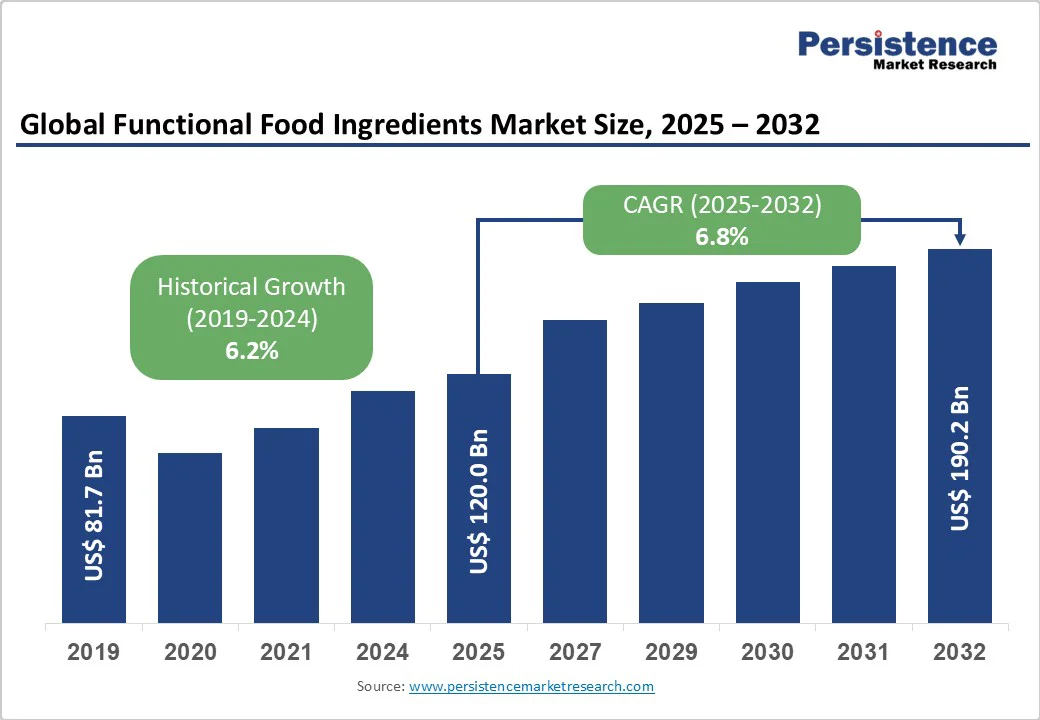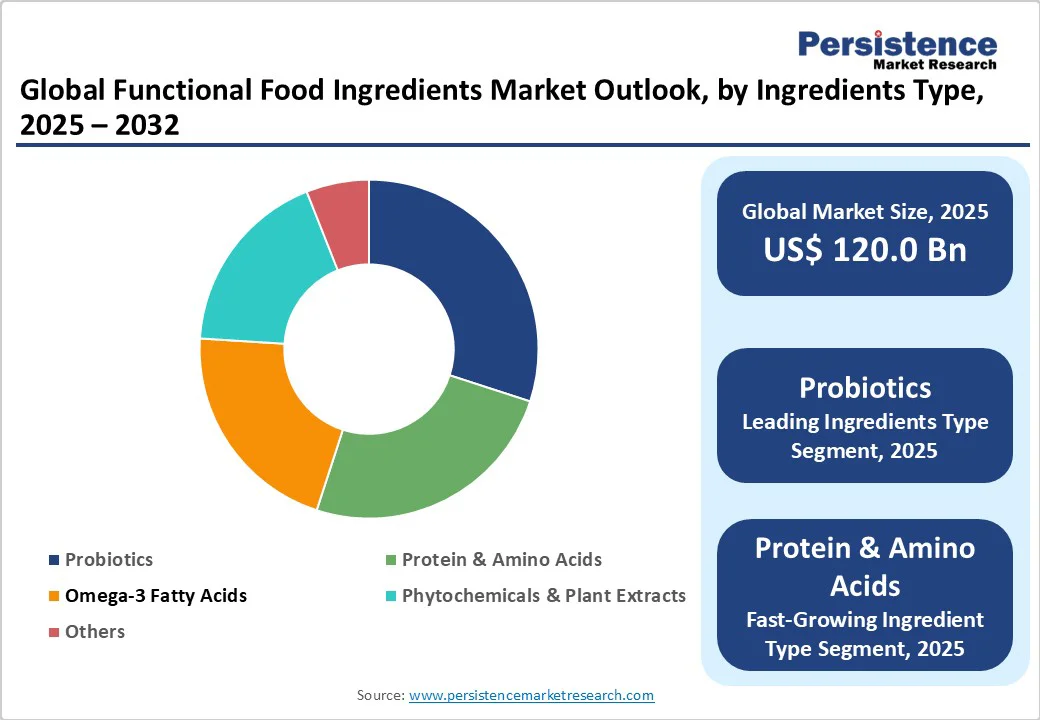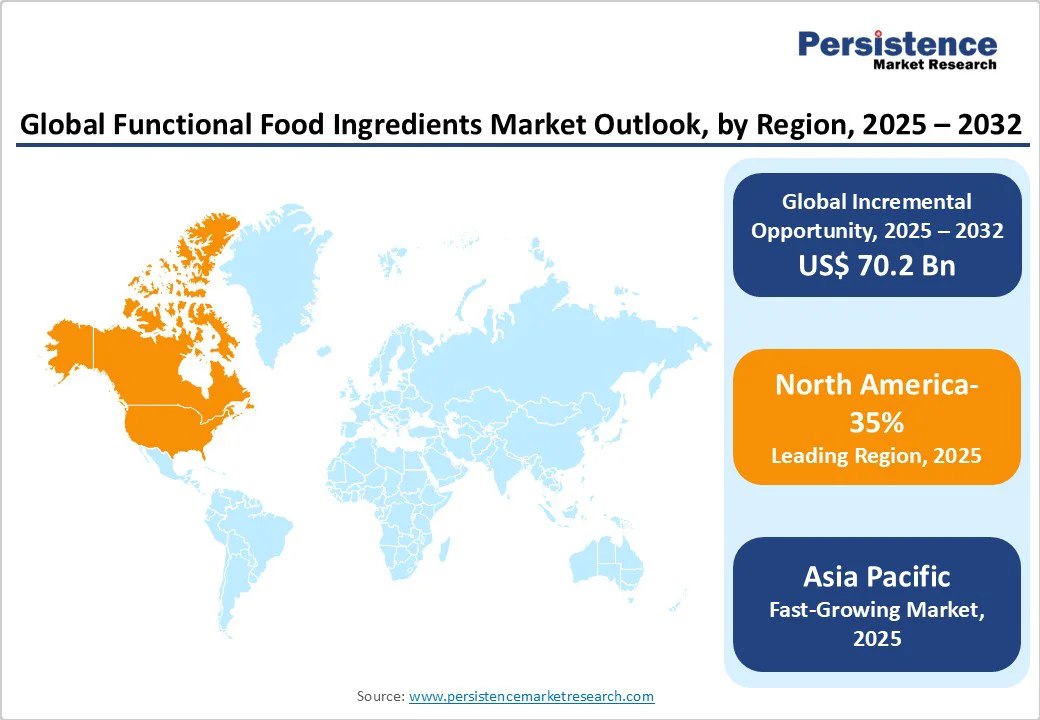ID: PMRREP31783| 190 Pages | 10 Oct 2025 | Format: PDF, Excel, PPT* | Food and Beverages

The global functional food ingredients market size is likely to be valued at US$120.0 bn in 2025 and is expected to reach US$190.2 bn by 2032, growing at a CAGR of 6.8% during the forecast period from 2025 to 2032.
Rising health consciousness and increasing demand for functional and fortified foods are driving growth. Consumers are seeking ingredients that support gut health, immunity, and overall well-being, while plant-based and clean-label products continue to gain popularity.
Additionally, the expansion of nutraceuticals and dietary supplements, coupled with innovation in probiotics and protein-based ingredients, is fueling widespread adoption across regions.
| Global Market Attribute | Key Insights |
|---|---|
| Functional Food Ingredients Market Size (2025E) | US$120.0 Bn |
| Market Value Forecast (2032F) | US$190.2 Bn |
| Projected Growth (CAGR 2025 to 2032) | 6.8% |
| Historical Market Growth (CAGR 2019 to 2024) | 6.2% |

The growing emphasis on health and wellness is significantly driving the functional food ingredients market. Consumers are increasingly seeking foods that offer benefits beyond basic nutrition, such as enhanced immunity, improved digestive health, and improved cognitive function.
This shift is evident in the rising demand for ingredients such as probiotics, prebiotics, and fortified vitamins. For instance, the Indian Ministry of Food Processing Industries (MoFPI) reports that fortified foods, including functional staples such as vitamin-fortified milk and cereals, have seen substantial adoption, reflecting the country’s move toward health-conscious consumption.
At the same time, the aging population is creating increased demand for functional ingredients specifically designed for older adults. With a significant portion of the population over 60, there is increasing interest in products that support bone health, heart health, and cognitive function.
Government initiatives promoting nutrition for senior citizens, such as fortified meal programs under public health schemes, demonstrate how demographic trends are encouraging innovation in functional foods and expanding market opportunities.
The functional food ingredients market faces significant restraints due to high production costs. Developing and processing specialized ingredients such as probiotics, prebiotics, and fortified nutrients requires advanced technology, quality control measures, and stringent testing. These factors increase the overall manufacturing expenses, making it challenging for smaller players to compete and limiting rapid market expansion.
Regulatory challenges further constrain market growth. Functional foods and their ingredients are subject to strict government guidelines regarding safety, labeling, and health claims. Compliance with varying regulations across regions can be time-consuming and costly, slowing down product launches and innovation. These combined financial and regulatory hurdles continue to impact the speed and scale of market development.
The rising awareness of health, sustainability, and ethical consumption is driving strong demand for plant-based functional food ingredients. Consumers are increasingly seeking alternatives to animal-derived products, leading to growth in ingredients such as plant proteins, fiber, and naturally derived bioactive compounds.
This shift is supported by the broader trend of plant-based diets, which not only promote wellness but also align with environmental and ethical considerations, creating substantial opportunities for innovation in functional food formulations.
Simultaneously, personalized nutrition is gaining momentum as consumers seek products tailored to their individual health needs, lifestyles, and genetic profiles. Functional food ingredients that address specific conditions, such as digestive health, immunity, or cognitive support, are seeing increased adoption.
Advances in nutrigenomics and data-driven dietary recommendations further enable the development of customized formulations, allowing manufacturers to cater to diverse consumer requirements and expand their market presence.
Probiotics remain the largest segment in the functional food ingredients market, capturing 30% market share in 2025. Their popularity is fueled by increased consumer focus on gut health, immunity, and overall well-being. Functional foods and beverages enriched with probiotics, such as yogurts and supplements, continue to see strong demand across various age groups, solidifying the segment’s leading position.
Protein and amino acids are emerging as the fastest-growing segment. The surge in demand for high-protein diets, sports nutrition, and muscle recovery products is driving this growth. Both plant-based proteins and specialized amino acids are gaining popularity, addressing the needs of health-conscious and vegan consumers, and positioning the segment for robust expansion in the coming years.
Natural functional food ingredients are expected to continue dominating, accounting for a 65% share in 2025. Their popularity is driven by growing consumer preference for clean-label, minimally processed, and naturally sourced products. Ingredients such as plant extracts, vitamins, and naturally derived bioactives are increasingly incorporated into functional foods and beverages, reflecting the demand for healthier and more transparent food options.
Synthetic ingredients are emerging as the fastest-growing segment. Advances in food technology and the need for consistent quality, stability, and cost-effectiveness are driving the adoption of synthetic vitamins, amino acids, and other functional compounds. The ability to precisely formulate products for targeted health benefits positions synthetic ingredients for accelerated growth in the functional food ingredients market over the coming years
The food and beverages segment continues to lead, accounting for around 50% market share in 2025. Its dominance is fueled by the growing inclusion of functional ingredients, such as probiotics, vitamins, and plant extracts, in everyday products like dairy, beverages, and snack items. Consumers are increasingly seeking convenient options that offer additional health benefits, thereby strengthening the segment’s strong market position.
Nutraceuticals and dietary supplements are the fastest-growing segment. Rising awareness about health, preventive care, and fitness is driving demand for protein powders, fortified capsules, and specialty amino acids. Innovations in product formulations and personalized nutrition solutions are further accelerating growth, making nutraceuticals and dietary supplements a key driver of growth in the functional food ingredients market.

The functional food ingredients market in North America is expected to capture 35% of the global share by 2025. This growth is fueled by rising consumer focus on health and wellness, strong demand for fortified and functional foods, and well-established distribution networks.
Continuous research and innovation in probiotics, nutraceuticals, and protein-based ingredients further strengthen the region’s position. Additionally, government programs promoting preventive healthcare, along with stringent food safety regulations, enhance consumer confidence. These combined factors reinforce North America’s role as the leading market, shaping trends and driving global adoption of functional food ingredients.
Europe is projected to hold a significant share of the functional food ingredients market, driven by growing consumer awareness of health and wellness and strong demand for fortified and natural products. The rising adoption of probiotics, vitamins, and plant-based ingredients, combined with well-established distribution networks, supports steady growth.
Government initiatives promoting nutrition and preventive healthcare, coupled with strict food safety regulations, further enhance consumer confidence. Innovation in nutraceuticals and personalized nutrition continues to strengthen Europe’s position, making it a key region influencing global trends in functional food consumption and product development.
Asia Pacific is emerging as the fastest-growing region, driven by rising health awareness, changing dietary habits, and increasing disposable incomes. Rapid urbanization and a growing middle-class population are boosting demand for fortified foods, protein-based ingredients, and probiotics.
Government initiatives promoting nutrition and preventive healthcare, along with the expansion of modern retail and e-commerce channels, support market growth. Additionally, innovation in personalized nutrition and plant-based ingredients is accelerating adoption across the region, positioning Asia Pacific as a key growth hub and an increasingly influential player in shaping global trends in functional food ingredients.

The global functional food ingredients market is highly competitive, driven by continuous innovation, new product launches, and strategic collaborations. Companies are focusing on expanding their product portfolios, enhancing ingredient quality, and adopting advanced technologies to meet evolving consumer demands.
Emphasis on clean-label, plant-based, and fortified ingredients is shaping market strategies. Additionally, regional expansion, partnerships, and mergers are common approaches to strengthen market presence, improve distribution networks, and capitalize on the growing demand for functional and personalized nutrition solutions.
The functional food ingredients market is projected to reach US$120.0 bn in 2025, driven by health-conscious consumers and nutraceutical demand.
Rising health awareness, aging populations, and plant-based trends fuel market growth.
The functional food ingredients market will grow from US$120.0 bn in 2025 to US$190.2 bn by 2032, with a CAGR of 6.8%.
Plant-based nutrition and personalized nutrition trends drive opportunities in food and supplements.
Leading players include DuPont, ADM, Cargill, BASF, Kerry, Tate & Lyle, Ingredion, Tereos, Meelunie, Roquette, Euroduna, and Blattmann.
| Report Attribute | Details |
|---|---|
| Historical Data/Actuals | 2019 - 2024 |
| Forecast Period | 2025 - 2032 |
| Market Analysis | Value: US$ Bn, Volume: As Applicable |
| Geographical Coverage |
|
| Segmental Coverage |
|
| Competitive Analysis |
|
| Report Highlights |
|
By Ingredients Type
By Source
By Application
By Region
Delivery Timelines
For more information on this report and its delivery timelines please get in touch with our sales team.
About Author